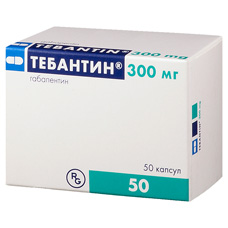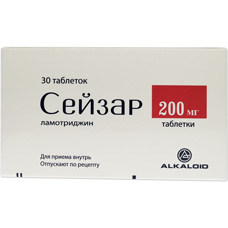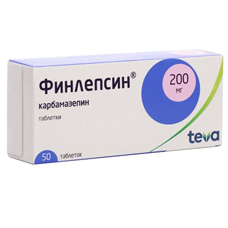
Katena®
Katena® is an antiepileptic drug, anticonvulsant. It is used to treat epilepsy and neuropathic pain.
Active substance:
GabapentinPharmachologic effect:
anticonvulsantPharmacodynamics:
Katena is an antiepileptic drug. According to the chemical structure, Gabapentin is similar to GABA, which acts as an inhibitory neurotransmitter in the central nervous system. The mechanism of action of gabapentin is believed to be different from other anticonvulsants that act through GABA synapses (including valproate, barbiturates, benzodiazepines, GABA transaminase inhibitors, GABA uptake inhibitors, GABA agonists, and GABA prodrugs). In vitro studies have shown that gabapentin is characterized by the presence of a novel peptide binding site in rat brain tissues, including the hippocampus and cerebral cortex, which may be related to the anticonvulsant activity of gabapentin and its derivatives. Gabapentin in clinically significant concentrations does not bind to other conventional drugs and neurotransmitter receptors in the brain, incl. with GABAA-, GABAB-, benzodiazepine receptors, with NMDA receptors.
The mechanism of action of gabapentin has not been definitively established.
Pharmacokinetics:
Gabapentin is absorbed from the gastrointestinal tract. After oral administration, Cmax of gabapentin in plasma is reached after 2-3 hours. Absolute bioavailability is about 60%. Reception simultaneously with food (including those with a high fat content) does not affect the pharmacokinetics of gabapentin.
Gabapentin does not bind to plasma proteins and has a Vd of 57.7 liters. In patients with epilepsy, the concentration of gabapentin in the cerebrospinal fluid is 20% of the corresponding plasma Css at the end of the dosing interval.
Gabapentin is excreted only by the kidneys. T1 / 2 does not depend on the dose and averages 5-7 hours.
Clearance of gabapentin is reduced in the elderly and in patients with impaired renal function. The elimination rate constant, plasma and renal clearance of gabapentin are directly proportional to creatinine clearance.
Gabapentin is removed from plasma by hemodialysis.
Plasma concentrations of gabapentin in children are similar to those in adults.
Indications:
- treatment of neuropathic pain in adults over the age of 18;
- monotherapy of partial seizures with and without secondary generalization in adults and children over 12 years of age;
- as an adjunct in the treatment of partial seizures with and without secondary generalization in adults and children aged 3 years and older.
Contraindications:
Hypersensitivity to gabapentin
Pregnancy and breast-feeding:
Adequate and strictly controlled studies on the safety of the use of gabapentin during pregnancy and lactation in humans have not been conducted. If necessary, use during pregnancy and lactation should carefully weigh the expected benefit of therapy for the mother and the potential risk to the fetus or infant.
Gabapentin is excreted in breast milk. When used during lactation, the nature of the action of gabapentin on an infant has not been established.
Side effects:
Nervous system:
amnesia, ataxia, confusion, impaired coordination of movements, depression, dizziness, dysarthria, increased nervous excitability, nystagmus, drowsiness, impaired thinking, tremor, convulsions, amblyopia, diplopia, hyperkinesia, strengthening, weakening or absence of reflexes, paresthesia, anxiety, hostility, gait disturbance.
Digestive system:
discoloration of the teeth, diarrhea, increased appetite, dry mouth, nausea, vomiting, flatulence, anorexia, gingivitis, abdominal pain, pancreatitis, changes in liver function tests.
Hematopoietic system:
leukopenia, a decrease in the number of leukocytes, thrombocytopenic purpura.
Respiratory system:
rhinitis, pharyngitis, cough, pneumonia.
Musculoskeletal system:
myalgia, arthralgia, bone fractures.
Cardiovascular system:
arterial hypertension, manifestations of vasodilation.
Urinary system:
urinary tract infections, urinary incontinence.
Allergic reactions:
erythema multiforme, Stevens-Johnson syndrome.
Dermatological reactions:
skin maceration, acne, itching, rash.
Other:
back pain, fatigue, peripheral edema, impotence, asthenia, malaise, swelling of the face, weight gain, accidental injury, asthenia, flu-like syndrome, blood glucose fluctuations, in children - viral infection, otitis media.
Interaction:
With simultaneous use with antacids, the absorption of gabapentin from the gastrointestinal tract decreases.
With simultaneous use with felbamate, an increase in T1 / 2 of felbamate is possible.
With simultaneous use, a case of an increase in the concentration of phenytoin in the blood plasma is described.
Dosing and Administration:
Katena capsules are taken orally, regardless of food intake, swallowing whole, drinking water. The dose should be selected individually, depending on the indication, age and condition of the patient. Dose reduction, withdrawal or replacement with alternative drugs should be done gradually over at least 1 week.
Special instructions:
Abrupt discontinuation of anticonvulsant therapy in patients with partial seizures may provoke status convulsions. If necessary, dose reduction, discontinuation of gabapentin or replacement with an alternative agent should be gradual over a period of at least 1 week.
Gabapentin is not an effective treatment for absence seizures.
When used together with other anticonvulsants, false-positive results of a urine protein test have been reported. To determine the protein in the urine, it is recommended to use a more specific method of precipitation of sulfosalicylic acid.
Patients with impaired renal function, as well as patients on hemodialysis, require correction of the dosing regimen.
Elderly patients may require correction of the gabapentin dosing regimen due to the fact that in this category of patients a decrease in renal clearance is possible.
The efficacy and safety of neuropathic pain therapy in patients under 18 years of age have not been established.
The efficacy and safety of gabapentin monotherapy in the treatment of partial seizures in children under 12 years of age and additional therapy with gabapentin in the treatment of partial seizures in children under 3 years of age have not been established.
Avoid drinking alcohol during treatment.
Before determining the individual response to treatment, the patient should refrain from potentially hazardous activities associated with the need for concentration and increased speed of psychomotor reactions.
Katena®
in Cyrillic : Катэна
SUBSTANCE
Gabapentin
DOSAGE FORM
capsules
Related Products
Finlepsin®
[ Carbamazepine ]
Antiepileptic pills, which also have antidepressant, antipsychotic and antidiuretic effects.
Out Of Stock




